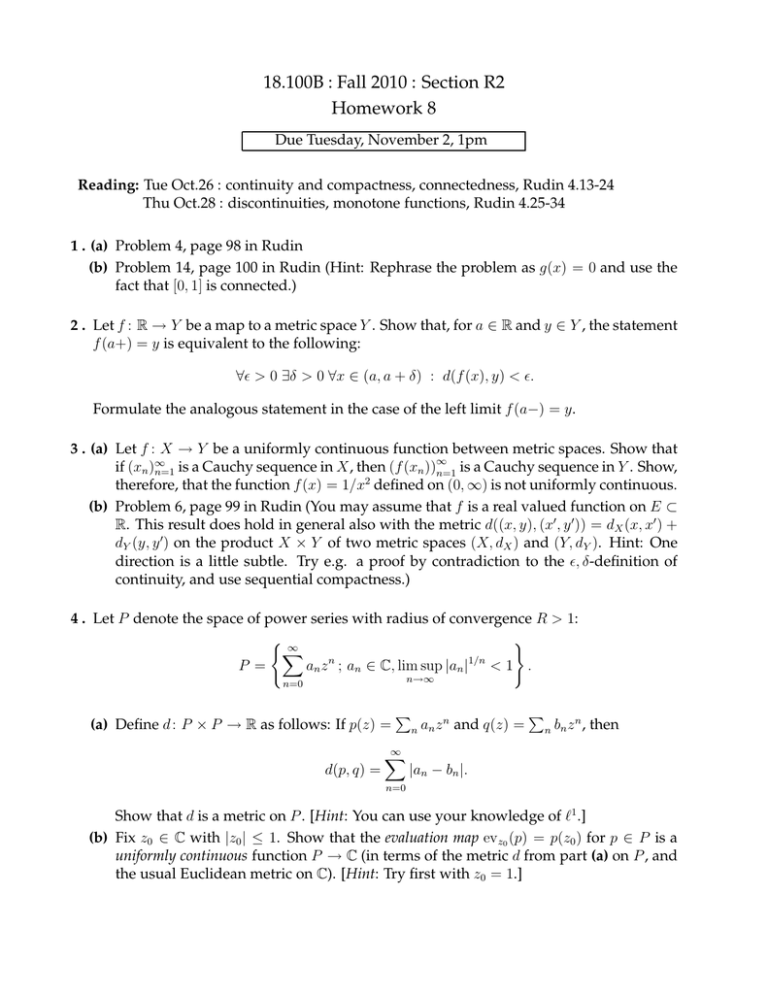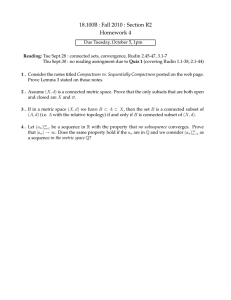Document 13584284
advertisement

18.100B : Fall 2010 : Section R2
Homework 8
Due Tuesday, November 2, 1pm
Reading: Tue Oct.26 : continuity and compactness, connectedness, Rudin 4.13-24
Thu Oct.28 : discontinuities, monotone functions, Rudin 4.25-34
1 . (a) Problem 4, page 98 in Rudin
(b) Problem 14, page 100 in Rudin (Hint: Rephrase the problem as g(x) = 0 and use the
fact that [0, 1] is connected.)
2 . Let f : R → Y be a map to a metric space Y . Show that, for a ∈ R and y ∈ Y , the statement
f (a+) = y is equivalent to the following:
∀ǫ > 0 ∃δ > 0 ∀x ∈ (a, a + δ) : d(f (x), y) < ǫ.
Formulate the analogous statement in the case of the left limit f (a−) = y.
3 . (a) Let f : X → Y be a uniformly continuous function between metric spaces. Show that
∞
if (xn )∞
n=1 is a Cauchy sequence in X, then (f (xn ))n=1 is a Cauchy sequence in Y . Show,
therefore, that the function f (x) = 1/x2 defined on (0, ∞) is not uniformly continuous.
(b) Problem 6, page 99 in Rudin (You may assume that f is a real valued function on E ⊂
R. This result does hold in general also with the metric d((x, y), (x′ , y ′)) = dX (x, x′ ) +
dY (y, y ′) on the product X × Y of two metric spaces (X, dX ) and (Y, dY ). Hint: One
direction is a little subtle. Try e.g. a proof by contradiction to the ǫ, δ-definition of
continuity, and use sequential compactness.)
4 . Let P denote the space of power series with radius of convergence R > 1:
� ∞
�
�
P =
an z n ; an ∈ C, lim sup |an |1/n < 1 .
n→∞
n=0
(a) Define d : P × P → R as follows: If p(z) =
d(p, q) =
�
∞
�
n=0
n
an z n and q(z) =
�
n bn z
n
, then
|an − bn |.
Show that d is a metric on P . [Hint: You can use your knowledge of ℓ1 .]
(b) Fix z0 ∈ C with |z0 | ≤ 1. Show that the evaluation map evz0 (p) = p(z0 ) for p ∈ P is a
uniformly continuous function P → C (in terms of the metric d from part (a) on P , and
the usual Euclidean metric on C). [Hint: Try first with z0 = 1.]
5 . Let (X, dX ) and (Y, dY ) be metric spaces. For any continuous map f : X → Y define a
function δf : X × (0, ∞) → (0, ∞) ∪ {∞} as follows:
δf (x, ǫ) = sup{δ > 0 | ∀t ∈ X dX (x, t) < δ ⇒ dY (f (x), f (t)) < ǫ}.
Note that this supremum may be ∞ if the continuity condition holds for all δ > 0; e.g.
for f constant. In the following, we use the definition of order < and infimum in the
extended reals.
(a) Show that the statement “f is continuous at x” is equivalent to ”δf (x, ǫ) > 0 for each
ǫ > 0”.
(b) Show that f is uniformly continuous on X iff inf x∈X δf (x, ǫ) > 0.
(c) Consider the function f (x) = x2 defined on the metric space X = [0, ∞). Show that
for each x ∈ X
sup
|f (x) − f (t)| = 2xδ + δ 2 .
t∈X,dX (x,t)<δ
√
√
(d) Use part (c) to show that δf (x, ǫ) = x2 + ǫ−x. Show that, for fixed ǫ > 0, limx→∞ [ x2 + ǫ−
x] = 0. Conclude that f is not uniformly√continuous on X. [Hint: you can use Cal­
culus here, but you needn’t. Set ϕ(x) = x2 + ǫ − x. Show that ϕ(x) ≥ 0, and that
ϕ(x)2 + 2x ϕ(x) = ǫ for every x. Hence 0 ≤ ϕ(x) ≤ ǫ/2x.]
2
MIT OpenCourseWare
http://ocw.mit.edu
18.100B Analysis I
Fall 2010
For information about citing these materials or our Terms of Use, visit: http://ocw.mit.edu/terms.






